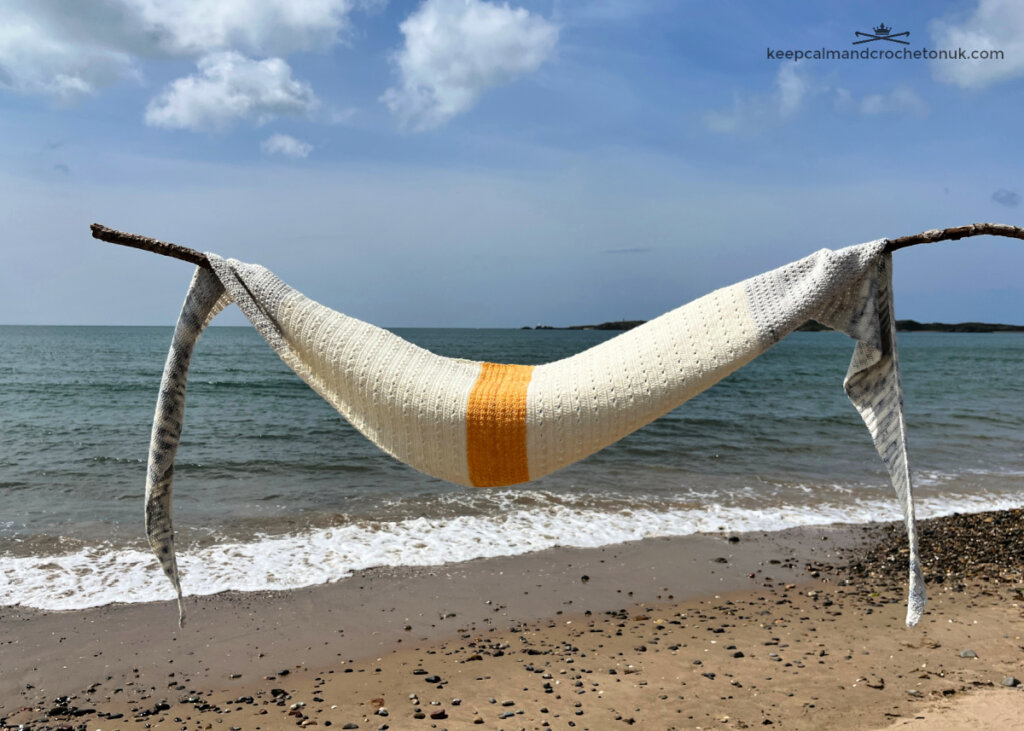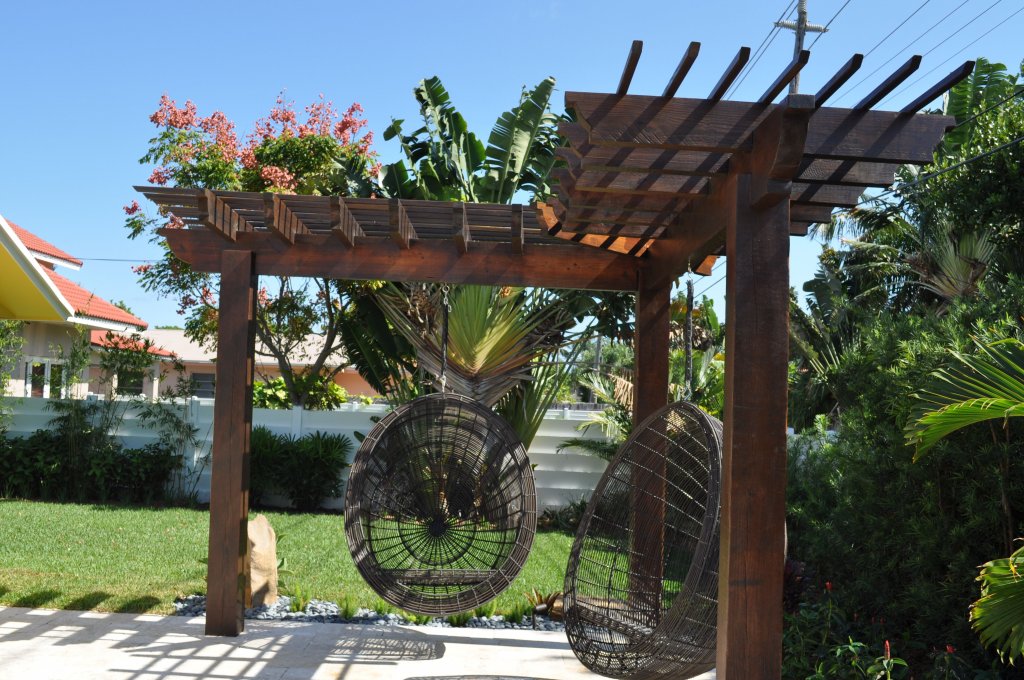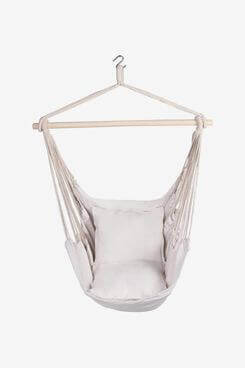- 8 Airplane Footrest Hammock!Travel comfortably - October 9, 2023
- top 7 Pool Float Water Hammock for a Relaxing Summer - October 9, 2023
- top 5 Space SaverSingle Hammock Stand Maximize Comfort and Space - October 9, 2023
A hanging chair is a suspended seat, while a hammock is a swing bed made of fabric. Hanging chairs are more like traditional chairs suspended from a stand or ceiling, providing a comfortable seating option.
On the other hand, hammocks are designed for lying down and offer a relaxing experience, perfect for lounging or taking a nap. The main difference lies in their purpose and seating position, with hanging chairs being upright and hammocks being horizontal.
Both options provide unique benefits and can enhance your outdoor or indoor space. Whether you prefer to sit or recline, choosing between a hanging chair and a hammock depends on your personal comfort and relaxation preferences. Now, let’s explore the characteristics and features of each in more detail to find the perfect fit for you.
Understanding The Basics
Understanding the BasicsIn order to fully appreciate the difference between a hanging chair and a hammock, it is crucial to understand the basic definitions and origins of these two popular seating options. Both types of furniture offer unique features and benefits, making them ideal choices for relaxation and unwinding. Let’s delve into the definitions of a hanging chair and a hammock, as well as explore their fascinating histories and traditional uses.Definition of a Hanging ChairA hanging chair is a suspended seat that typically consists of a frame with a chair-like design. Resembling a swing, this type of furniture hangs from a single point, allowing for gentle rocking motions. The chair may be supported by chains, ropes, or a combination of both, ensuring stability and comfort. As an inviting and versatile seating option, a hanging chair adds a touch of style and comfort to any indoor or outdoor space.Definition of a HammockA hammock is a type of suspended bed or couch that is commonly made of fabric or netting. Traditionally, a hammock is suspended between two points, such as trees or posts, using ropes. Its design allows for even weight distribution, creating a cocoon-like feeling of weightlessness. Hammocks are known for their soothing rocking motion, making them an excellent choice for relaxation and napping.Brief History and OriginsThe history of hanging chairs and hammocks can be traced back to ancient civilizations. Hammocks have a rich history dating back thousands of years. They were first used by the indigenous inhabitants of Central and South America, who recognized their comfort and practicality. Hammocks were widely embraced by sailors during their voyages, as they provided a comfortable place to sleep aboard ships. Over time, various cultures adopted hammocks as a preferred sleeping option, leading to their popularity around the world today.On the other hand, hanging chairs have a more recent origin. While suspended seats have been used in different forms throughout history, the modern hanging chair as we know it today gained popularity in the mid-20th century. Combining style and functionality, hanging chairs became a fashionable addition to home interiors and outdoor spaces.How They Are Traditionally UsedHanging chairs and hammocks have distinct traditional uses. Hammocks are renowned for their application in outdoor settings, such as gardens, beaches, and campsites. Parents often use hammocks to gently sway their babies to sleep due to the calming sensations they provide. Additionally, hammocks are frequently seen in tropical climates, where their breathability and flexibility offer respite from the heat.On the other hand, hanging chairs are versatile and can be used both indoors and outdoors. Many homeowners incorporate hanging chairs into their indoor spaces, such as living rooms, bedrooms, or reading nooks, to add a unique touch of relaxation. Outdoors, hanging chairs are commonly found on patios, porches, and other outdoor entertaining areas, creating inviting spots to unwind and enjoy the surrounding scenery.Understanding the key differences between hanging chairs and hammocks, along with their definitions, histories, and traditional uses, allows you to make an informed choice when selecting the perfect seating option for your space. Whether you prefer the cocoon-like comfort of a hammock or the stylish versatility of a hanging chair, both options provide an opportunity to create a serene haven for relaxation and rejuvenation.Construction And Design
Materials Used For Hanging Chairs
Hanging chairs are typically made from a variety of materials, each offering unique features and benefits. One common material used in the construction of hanging chairs is rattan. Rattan is a natural material that is known for its strength and durability. It is also lightweight, making it easy to move the hanging chair from one location to another. Another popular material used for hanging chairs is wicker. Wicker is typically made from natural fibers that are woven together to create a sturdy and supportive seat. Synthetic materials such as polyester and nylon are also commonly used in the construction of hanging chairs. These materials are known for their resistance to weather conditions, making them ideal for outdoor use.
Materials Used For Hammocks
Hammocks are typically made from natural or synthetic materials, depending on the desired level of durability and comfort. One of the most common materials used for hammocks is cotton. Cotton hammocks are soft and breathable, making them perfect for lounging and relaxation. However, cotton hammocks may not be as durable as those made from synthetic materials. Another popular material for hammocks is nylon. Nylon is known for its strength and resistance to wear and tear. It is also lightweight and quick-drying, making it suitable for outdoor use. Polyester is another synthetic material used in the construction of hammocks. Polyester hammocks are durable and weather-resistant, making them ideal for long-term outdoor use.
Differences In Shape And Size
When comparing hanging chairs and hammocks, one noticeable difference is their shape and size. Hanging chairs typically have a more compact and defined shape, resembling a chair with a backrest and armrests. They are designed to provide a comfortable seating experience. Hammocks, on the other hand, have a more elongated shape, resembling a sling or a bed. They are meant for lounging and relaxation, allowing the user to stretch out and fully recline. Hammocks are generally larger in size compared to hanging chairs, providing ample space for individuals to lie down comfortably.
Support And Suspension Systems
Both hanging chairs and hammocks require reliable support and suspension systems to ensure safety and stability. Hanging chairs are typically suspended from a single point or multiple points, depending on the design. They often come with a sturdy chain or rope that is attached to a ceiling or a specially designed stand. Hammocks, on the other hand, require two fixed anchor points, such as trees or posts, to be securely attached. They are usually supported by ropes or straps that are tightly secured to the anchor points. The support and suspension systems used for hanging chairs and hammocks vary, but their purpose remains the same – to provide a safe and comfortable seating or lounging experience.
Comfort And Ergonomics
If you’re in the market for a new outdoor relaxation spot, you may be torn between a hanging chair and a hammock. Both options have their unique benefits, but when it comes to comfort and ergonomics, they offer different features and advantages. Let’s explore how cushioning, weight distribution, adjustability, and body posture play a role in the comfort and overall experience of these two outdoor seating options.
Cushioning And Padding In Hanging Chairs
When it comes to cushioning and padding, hanging chairs take the lead. These chairs are often designed with extra thick cushions and padding, providing you with a luxurious and comfortable seating experience. Whether it’s foam padding or soft fabric cushions, hanging chairs prioritize comfort by offering a soft and supportive sitting surface. The additional padding ensures that you can spend hours in your hanging chair without feeling any discomfort or pressure points. With a variety of materials and designs available, you can easily find a hanging chair that suits your personal preference and offers the perfect level of cushioning.
How Hammocks Distribute Weight And Provide Comfort
Hammocks, on the other hand, use weight distribution to provide comfort. The entire weight of your body is evenly distributed across the surface of the hammock, eliminating any pressure points. This allows for a sensation of weightlessness and relaxation. Unlike hanging chairs, hammocks usually don’t come with additional padding or cushioning. Instead, they rely on the natural curve of your body to provide comfort. The fabric or netting of the hammock contours to your body shape, creating a supportive and comfortable cradle.
Adjustability And Customization Options
Hanging chairs offer greater adjustability and customization options compared to hammocks. With a hanging chair, you have the flexibility to adjust the height and angle of the chair to your liking. You can find hanging chairs that come with adjustable chains, ropes, or even mechanisms for easy adjustments. This allows you to find the perfect seating position and customize your comfort. On the other hand, hammocks are generally fixed in terms of their shape and size. While you can adjust the tension to some extent, the customization options are limited compared to hanging chairs.
Impact On Body Posture, Ensuring Each H3 Heading Adheres To Html Syntax
Both hanging chairs and hammocks have a positive impact on body posture. Hanging chairs provide excellent lumbar support, ensuring that your back is properly aligned and preventing any strain or discomfort. The padded seat and backrest promote a healthy sitting posture, relieving pressure on your spine. Hammocks, on the other hand, provide a natural curvature for your body, mimicking the position your body takes while sleeping or lounging. This supports your spine’s natural alignment and reduces the strain on your back and neck.

Credit: opensea.io
Usage And Portability
When it comes to choosing the perfect outdoor seating option, hanging chairs and hammocks are two popular choices that offer relaxation and comfort. Understanding the difference between a hanging chair and a hammock can help you make an informed decision based on your needs and preferences. In this article, we will explore the usage and portability of hanging chairs and hammocks, focusing on their versatility, ideal locations, and weight and compactness for easy transportation.
Versatility Of Hanging Chairs
Hanging chairs are known for their versatility, making them suitable for various settings. They come in different styles and designs, including hammock chairs, egg chairs, and swing chairs. Unlike traditional hammocks, hanging chairs typically feature a seat that is suspended from a single point, providing a cozy and comfortable seating option.
One of the advantages of hanging chairs is that they can be placed in both indoor and outdoor spaces. They offer a unique seating experience, allowing you to relax and swing gently. Hanging chairs are great for reading a book on the porch, enjoying a cup of coffee in the garden, or even as a stylish addition to your living room or bedroom.
Ideal Locations For Hanging Chairs
Hanging chairs are versatile enough to be used in various locations, both indoors and outdoors. Here are some ideal locations for hanging chairs:
- Outdoor patio or veranda
- Garden or backyard
- Balcony or terrace
- Living room or bedroom
- Children’s playroom
The portability of hanging chairs allows you to easily move them from one location to another, depending on your mood or the occasion. Their versatile nature makes them a popular choice for those who want to add a cozy and stylish seating option to different areas of their homes.
Hammocks For Outdoor And Indoor Use
Unlike hanging chairs, hammocks are designed primarily for outdoor use, although they can also be used indoors with the right setup. Hammocks are made of a fabric or netting material suspended between two fixed points, such as trees, posts, or a hammock stand, providing a comfortable surface for relaxation or sleep.
Outdoor hammocks are perfect for enjoying the fresh air, whether you want to take a nap in your backyard or go camping in the wilderness. They are also popular among beachgoers who want to lie back and soak up the sun. Indoor hammocks can be installed in spacious living areas or even as a unique addition to a bedroom, creating a cozy and relaxing space for unwinding.
Weight, Compactness, And Ease Of Transport
When it comes to portability, hanging chairs are generally lighter and more compact than full-sized hammocks. Hanging chairs can be easily disassembled, folded, or stacked, making them convenient to transport and store. Some hanging chairs also come with carrying bags or cases, allowing you to take them on picnics, camping trips, or vacations.
Hammocks, on the other hand, are larger and require more space for transportation. While portable camping hammocks are designed to be lightweight and easy to carry, traditional hammocks may be bulkier and heavier. It is important to consider the weight and compactness of your preferred seating option if you plan to move it frequently or take it on trips.
In conclusion, hanging chairs and hammocks provide different seating experiences in terms of usage and portability. Hanging chairs are versatile, suitable for both indoor and outdoor use, while hammocks are primarily designed for outdoor relaxation. When it comes to weight, compactness, and ease of transport, hanging chairs are generally lighter and more portable than traditional hammocks. Consider your specific needs and the available space when deciding between a hanging chair and a hammock for your ultimate relaxation spot.
Aesthetics And Visual Appeal
When it comes to outdoor furniture, aesthetics and visual appeal play a significant role in creating an inviting and stylish space. Both hanging chairs and hammocks offer unique designs and styles that can enhance the ambiance of any outdoor area. Whether you prefer a modern and sleek look or a more traditional and rustic feel, understanding the differences in aesthetics between hanging chairs and hammocks can help you choose the perfect option for your outdoor retreat.
Hanging Chair Designs And Styles
Hanging chairs are designed to provide a comfortable and relaxing seating experience while also adding a touch of elegance to any outdoor space. These chairs hang from a sturdy frame or a ceiling mount, allowing for a suspended seating position. The designs and styles of hanging chairs vary widely, ranging from minimalist and contemporary to bohemian and vintage-inspired.
If you prefer a minimalist aesthetic, you can opt for a hanging chair with clean lines, neutral colors, and a sleek design. These chairs blend seamlessly with modern outdoor settings, providing a sophisticated and understated look. On the other hand, if you prefer a bohemian or vintage style, you can choose a hanging chair with intricate patterns, ornate details, and vibrant colors to add a whimsical and artistic touch to your outdoor space.
Hammock Designs And Patterns
Hammocks, on the other hand, are designed for ultimate relaxation and comfort. These iconic pieces of outdoor furniture typically consist of a fabric sling suspended between two anchor points, such as trees or posts. Hammocks come in a variety of designs and patterns, allowing you to express your personal style while enjoying the laid-back comfort they offer.
Whether you prefer a classic rope hammock, a quilted hammock, or a Brazilian-style hammock, there are numerous options to choose from. Some hammocks feature intricate weaves and patterns that add visual interest and a bohemian flair to your outdoor space. Others come in solid colors or simple stripes, offering a more minimalist and contemporary look. The wide range of hammock designs and patterns ensures that you can find the perfect match for your desired aesthetic.
Different Colors And Fabric Options
Another aspect that sets hanging chairs and hammocks apart in terms of aesthetics is the availability of different colors and fabric options. Hanging chairs often come in a variety of materials, such as rattan, wicker, or synthetic fibers, each offering its own visual appeal and texture. These chairs are commonly available in earth tones, neutral shades, and vibrant hues, allowing you to choose a color that blends harmoniously with your outdoor surroundings.
On the other hand, hammocks typically come in a wide range of fabric options, from cotton and polyester to weather-resistant materials like nylon or Sunbrella. This variety of fabrics not only provides different textural experiences but also enables you to select a color and pattern that suits your personal style and complements your outdoor decor. Whether you prefer a bright and cheerful hammock or a more subdued and natural color palette, there is a fabric option available to meet your preferences.
Enhancing The Ambiance Of The Space
Both hanging chairs and hammocks have the power to enhance the overall ambiance of your outdoor space. The visual appeal and unique designs they offer create focal points, drawing attention and adding a sense of charm to your patio, garden, or porch. Whether you choose a hanging chair or a hammock, incorporating these pieces into your outdoor decor can instantly elevate the aesthetics of your space and create a cozy and inviting atmosphere.
Frequently Asked Questions Of What Is The Difference Between A Hanging Chair And A Hammock
What Is A Hanging Chair For?
A hanging chair is designed for relaxation and comfort. It offers a unique seating experience, suspended from a sturdy frame or ceiling, providing a gentle, swinging motion. It is perfect for outdoor or indoor spaces, allowing you to unwind, read a book, or simply enjoy the tranquility.
Can I Hang My Hammock Like A Chair?
Yes, you can hang your hammock like a chair. Just make sure to use a hammock chair stand or find a sturdy point to hang it from, ensuring it is at a comfortable height and securely fastened. Enjoy the cozy relaxation of your hammock chair!
Are Hanging Chairs Actually Comfortable?
Hanging chairs are indeed comfortable due to their ergonomic design and sling-like seating. The suspended swing motion alleviates pressure points, while the gentle swaying promotes relaxation and offers additional comfort. These chairs provide a cozy and enjoyable experience for both indoor and outdoor use.
Are Hanging Chairs Good For Your Back?
Hanging chairs can be good for your back as they provide support and help improve posture. The hanging motion can also help relax muscles and reduce tension. However, it’s important to ensure you choose a chair with proper lumbar support for optimal back health.
What Is A Hanging Chair?
A hanging chair is a suspended seat that provides a comfortable place to sit and relax. It is usually made of durable materials like rattan or rope and can be hung from a stand or a strong support structure.
What Is A Hammock?
A hammock is a sleeping or lounging apparatus that consists of a fabric sling suspended between two anchor points. It is designed for outdoor use and offers a comfortable and suspended place to rest or sleep.
What Is The Main Difference Between A Hanging Chair And A Hammock?
The main difference between a hanging chair and a hammock is their design and purpose. A hanging chair provides a seat for relaxation, while a hammock is primarily used for sleeping or lounging horizontally.
Conclusion
To sum up, the main difference between a hanging chair and a hammock lies in their designs and functions. While a hanging chair provides a comfortable and relaxing seating option, a hammock offers a full-body reclining experience. It’s important to consider your preferences and the space available when choosing between the two.
Both options can enhance your outdoor or indoor living space, providing a cozy spot to unwind and enjoy leisure time.






